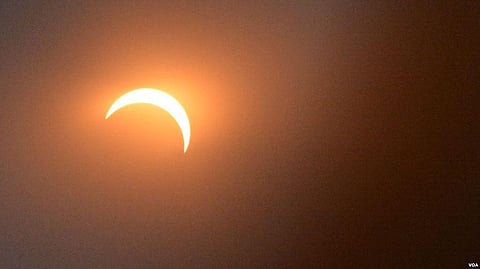
- Home
- NG Hindi
- India
- World
- Politics
- Sex & Relationships
- Entertainment
- Culture
- Lifestyle
- Economy
- Sports
- Sp. Coverage
- Misc.
- NewsGram Exclusive
- Jobs / Internships

Washington D.C. [USA], August 22, 2017: Millions of people across the United States watched a rare total solar eclipse which darkened the skies from the Pacific to the Atlantic for the first time in 99 years.
The eclipse began Monday morning in the Western state of Oregon, causing the temperature to drop significantly as the moon covered the sun.
An estimated 200 million people were within a day's drive of Monday's path of totality, which stretched from Oregon's Pacific Coast, across the U.S. heartland, all the way to South Carolina's Atlantic Coast.
Millions Across US Marvel at Total Solar Eclipse. Photo Credit: (NASA/Aubrey Gemignani)
Cities, towns and parks across the path had prepared for an influx of people with telescopes, cameras and protective glasses to watch what NASA said it expected to be the most watched and documented eclipse in history.
More than 100,000 people gathered in Madras, a town in Oregon with a population of 7,000 and one of the first places to witness the celestial event. According to the Los Angeles Times, the National Guard had to be called in to assist with traffic jams in Madras because so many people wanted to view the eclipse there.
The total eclipse lasted longest near Carbondale, Illinois, at 2 minutes and 44 seconds.
"It's chilling, it's cool, it's a life experience," said Gregg Toland, who traveled from Palatine, Illinois, to the airport in Perryville, Missouri, to see the eclipse in the path of totality through his telescope.
"It's something you'll never forget," he told VOA.
Total Solar Eclipse on August 21, 2017. Google Maps, NASA.
The path of totality, where the moon's shadow completely covered the sun, was a band about 100 kilometers wide, which cut diagonally across the country. Those outside that narrow band could still see a partial eclipse, extending up to Canada and down to the top of South America.
Observers at Los Angeles' Griffith Observatory gathered to witness the partial eclipse. "Seeing it in person was actually pretty cool because I was watching videos on YouTube. Seeing it in YouTube and seeing it real life is a whole different thing," Jason Salamanca told VOA.
"When you see it on TV, you see it through other people's eyes, but when you see it with your own eyes, it's like a very different experience. It's something I've never seen before," said Angie Salamanca at the Griffith Observatory.
Woman looks up at sun after getting special eclipse viewing glasses at the Smithsonian Air And Space Museum in Washington, D.C., Aug. 21, 2017. (Photo: Georgia Lawson / VOA)
Hundreds of people waited in a line outside the National Air and Space Museum in Washington to see the moon cover more than 80 percent of the sun over the nation's capital.
"It's a once-in-a-lifetime opportunity," Shawdi, who watched the partial eclipse outside the museum, told VOA. "Who knows when the next total eclipse will be, so it's just great sharing this memory with everyone," she said.
The first city to enter totality was Lincoln Beach, Oregon, at 10:16 a.m. Pacific time and the last city to exit the totality was Charleston, South Carolina, at 2:48 p.m. Eastern time.
NASA video of the total solar eclipse in Hopkinsville, Kentucky:
A total solar eclipse happens when the moon passes between the Earth and the sun and completely blots out the sun's light, except for the corona of its outer atmosphere.
From Earth, the moon appeared to be the same size as the sun. This was possible because while the moon is 400 times smaller than the sun in diameter, it is also 400 times closer to Earth than the sun. When the two lined up exactly, the skies went dark.
The next total solar eclipse to touch the United States won't be for another seven years. Outside of the United States, the next eclipse will occur in 2019 and will be visible from the South Pacific, Chile and Argentina.
VOA's Kane Farabaugh, Carolyn Presutti and Elizabeth Lee contributed to this report.
